Fantasia 2016, Day 19: Critiques of Cartesian Dualism, Plus an Elk (Embers, L’Élan, We Are the Flesh)
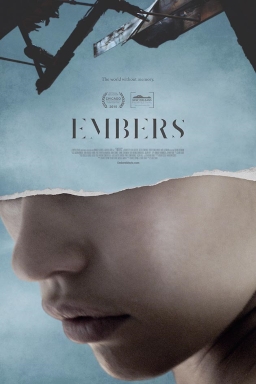 By Monday, August 1, the end of the 2016 Fantasia Film Festival was in sight. Two more days, and it’d be over for another year. Bearing that in mind I was determined to pass by the Festival’s screening room and catch up with some films I’d missed earlier in the festival. First, though, I was headed to the De Séve Theatre for a showing of the American-Polish science-fiction movie Embers, about a world struck by a plague of forgetting. After that I’d go to the screening room, where I’d watch the French absurdist comedy L’Élan and the Mexican horror-fantasy We Are the Flesh (Tenemos la carne).
By Monday, August 1, the end of the 2016 Fantasia Film Festival was in sight. Two more days, and it’d be over for another year. Bearing that in mind I was determined to pass by the Festival’s screening room and catch up with some films I’d missed earlier in the festival. First, though, I was headed to the De Séve Theatre for a showing of the American-Polish science-fiction movie Embers, about a world struck by a plague of forgetting. After that I’d go to the screening room, where I’d watch the French absurdist comedy L’Élan and the Mexican horror-fantasy We Are the Flesh (Tenemos la carne).
A short film called “Event Horizon” played before Embers. Directed and written by Josépha Celestin, it’s a sweet but slow film about a young girl (Kate McLaughlin) in 1997 with a desire to explore, and a black hole that appears not far from her home in a Scottish village. Other youths aren’t as idealistic as she is, providing some tension to the piece. It’s an understated story, for good or ill, with striking cinematography. It’s remarkable for doing something character-based with a distinctly science-fictional premise.
Embers is the first feature film from director Claire Carré, with a script by Carré and Charles Spano. It gives us a future in which the world’s afflicted by a mysterious global plague robbing its victims of their short-term memories. The plague struck ten years before the film begins, and seems to have infected virtually everyone. Embers follows several different plot strands — some of which overlap and some of which do not — in the decayed world that has resulted. Time having passed since I saw Embers at Fantasia, I will note that it’s now on Netflix in Canada and the US; and I will say at once that anyone looking for a cerebral yet character-centred science-fiction film should see this movie. Well-crafted and elliptical, it avoids presenting easy answers or obvious genre structural strategies while being science-fiction in the most profound sense, using a nominally technologically-based shift in the world to raise questions about identity and human nature.
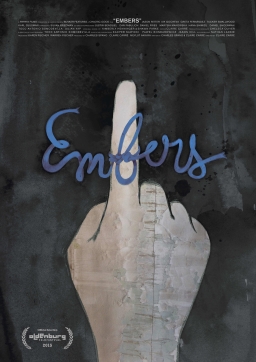 We’re introduced to a ruined urban setting and slowly put together what has happened and what it is we’re seeing. There are lovers (Iva Gocheva and Jason Ritter) waking up and rediscovering each other. There is a philosopher (Tucker Smallwood) studying his books, trying to understand memory and the secret of remembering. There is a mute boy (Silvan Friedman). There is an angry, chaotic young man (Karl Glusman). And there is a woman, Miranda (Greta Fernández), who lives with her father (Roberto Cots) in an underground bunker safe from the effects of the plague, where art and history live on — but where Miranda is growing increasingly frustrated with her isolation from the world.
We’re introduced to a ruined urban setting and slowly put together what has happened and what it is we’re seeing. There are lovers (Iva Gocheva and Jason Ritter) waking up and rediscovering each other. There is a philosopher (Tucker Smallwood) studying his books, trying to understand memory and the secret of remembering. There is a mute boy (Silvan Friedman). There is an angry, chaotic young man (Karl Glusman). And there is a woman, Miranda (Greta Fernández), who lives with her father (Roberto Cots) in an underground bunker safe from the effects of the plague, where art and history live on — but where Miranda is growing increasingly frustrated with her isolation from the world.
This is not a movie that imagines a story of characters solving problems and restoring civilisation. It’s not even a story that provides many answers about its background. Only those answers that are essential, building its world just as much as it needs in order to follow its characters. When we understand the nature of the plague and how long ago it hit, we understand that the mute boy cannot remember how to speak. We meet a girlish young woman, and realise that she cannot move on from girlhood. Removing the ability to remember removes the ability to learn, to grow, to mature.
Visually the sense of run-down places is constant and almost horrific. We’re seeing a world in which human constructions are being overgrown, are decaying and returning to nature. The characters wander in an echoing emptiness, where other people are dangers and wonders. It is also a physical world — characters reach out, touch each other and their surroundings, as though to impress on their bodies the passing of time that cannot leave impressions on their mind.
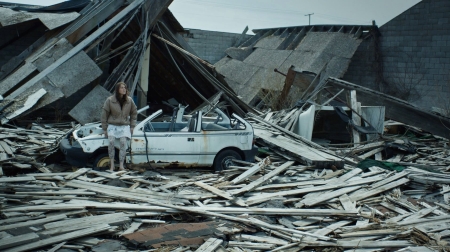 I found myself reminded of prose science fiction’s New Wave. The elliptical structure that confounds typical narrative expectations; the way human character is interrogated through a science-fictional idea with no technical explanations; the sheer formal skill. The high concept here even sounds a little like Gene Wolfe’s Latro series, but inverted: instead of one character who loses his memory every day, all the world loses their memory each morning except for one character. If the film doesn’t have the plot intricacy of a Wolfe novel, it still has a similar thematic richness (without necessarily sharing a theme).
I found myself reminded of prose science fiction’s New Wave. The elliptical structure that confounds typical narrative expectations; the way human character is interrogated through a science-fictional idea with no technical explanations; the sheer formal skill. The high concept here even sounds a little like Gene Wolfe’s Latro series, but inverted: instead of one character who loses his memory every day, all the world loses their memory each morning except for one character. If the film doesn’t have the plot intricacy of a Wolfe novel, it still has a similar thematic richness (without necessarily sharing a theme).
Each of the threaded stories we follow in Embers has its own beginning, middle, and end — though given the nature of the setting, some of the endings are also returnings to the beginnings. The movie plays up the ambiguity of that: good and bad experiences both wiped away. And yet some changes stick. Is character shaped by only what we know of the past? Are we our memories? Or are we made of something deeper? If we lose our sense of time, are we freed to be different each day, or are we trapped inside recurring loops? Different characters suggest different answers to these questions. Perhaps the title reinforces the movie’s ambiguity: if we are watching the embers of a burnt world, if these characters have been burnt down to embers, then they may be close to going out but also might flare up again into health.
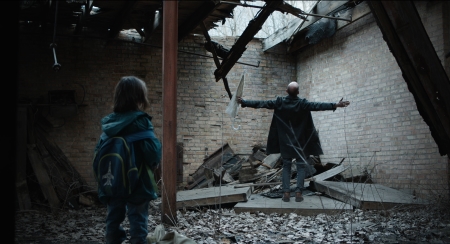 Bearing this in mind it’s difficult not to be especially drawn to the story of Miranda and her father in their underground bunker. They’re the only characters to know what’s happened to them, to understand their situation. They’re also the only characters to have a sense of continuity. Miranda’s father in particular has an understanding of tradition and history otherwise almost absent from the film — Tucker Smallwood’s philosophical Teacher (as he is described at the IMDB) tries, but the forgetting-plague undercuts him with every word he reads or writes.
Bearing this in mind it’s difficult not to be especially drawn to the story of Miranda and her father in their underground bunker. They’re the only characters to know what’s happened to them, to understand their situation. They’re also the only characters to have a sense of continuity. Miranda’s father in particular has an understanding of tradition and history otherwise almost absent from the film — Tucker Smallwood’s philosophical Teacher (as he is described at the IMDB) tries, but the forgetting-plague undercuts him with every word he reads or writes.
Miranda’s father, who stares at art and encourages his daughter to play the cello, is then the only character able to articulate the importance of the past in shaping the present. “What you do is who you are,” he says, and: “As long as there is one person playing the cello or one person admiring a painting then what is uniquely human still exists.” He’s built a citadel or island of art, in which the remaining embers of the fires of creation are banked under ashes. It is perfectly appropriate that Miranda’s story is the most directly allusive of all the threads we follow: she is like Shakespeare’s Miranda, isolated from the external world by her wizard-father, with a computer-servant speaking to her from thin air like an elemental spirit. And yet, she chooses in the end a different path than her literary predecessor.
 In this, and in the way the characters so often reach out to touch each other as part of the process of communication, there is a sense in which the film seems to value physicality over the intellect. But I’m not sure that’s so; that physicality is perhaps what’s left when the intellect is eliminated. Miranda’s problem is one of imbalance, and not of the tyranny of the cerebral. I would say the film is certainly about the need for connection with other people, and the ways in which that contact can go horribly wrong; and that is true of her story as it is of many others.
In this, and in the way the characters so often reach out to touch each other as part of the process of communication, there is a sense in which the film seems to value physicality over the intellect. But I’m not sure that’s so; that physicality is perhaps what’s left when the intellect is eliminated. Miranda’s problem is one of imbalance, and not of the tyranny of the cerebral. I would say the film is certainly about the need for connection with other people, and the ways in which that contact can go horribly wrong; and that is true of her story as it is of many others.
But then one can say the film’s about very many things. About growth, perhaps, and how growth is impossible in an eternal now. About the way we learn, too. About what we feel and what we think matters. The film is relatively brief, only 85 minutes, but there’s an awful lot to unpack within it. Technically, the movement between storylines works, each contrasting with each and collectively building a full picture of a devastated world; and the acting is fine, especially perhaps Gocheva and Ritter, who lend a kind of innocence to their amnesiac lovers that makes one think of a kind of parody of Eden: an eternal now in which love is always being reborn. The pacing gives scenes room to breathe and silent moments to explore, but is overall swift. And the ending’s solid and bittersweet, stopping at the exact right point at which to suggest many ways for things to go. Embers is a touching, intelligent work of science fiction. It deserves to be widely seen.
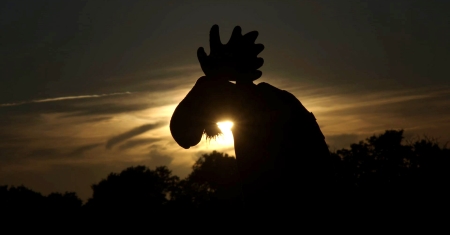 From the De Sève I went to the screening room, where I had time to watch two relatively short movies. I decided to try my luck first with a comedy called L’Élan (translated directly into English as The Elk). Directed by Etienne Labroue from a screenplay by Labroue and Marc Bruckert, it is more than a little baffling. Near a small village in the Vendée, in France, at roughly the same time a TV host (Bernard Montiel, playing himself) has a car accident, a mysterious elk-headed creature meets a local woman. These things play out in a film that seems to be a straight-faced parody of movies like E.T. or Starman, with a voice-over moving things along.
From the De Sève I went to the screening room, where I had time to watch two relatively short movies. I decided to try my luck first with a comedy called L’Élan (translated directly into English as The Elk). Directed by Etienne Labroue from a screenplay by Labroue and Marc Bruckert, it is more than a little baffling. Near a small village in the Vendée, in France, at roughly the same time a TV host (Bernard Montiel, playing himself) has a car accident, a mysterious elk-headed creature meets a local woman. These things play out in a film that seems to be a straight-faced parody of movies like E.T. or Starman, with a voice-over moving things along.
There are rural bumpkins with a yen for hunting elks. There is an investigator of extraterrestrials (Arsène Mosca) with binders full of aliens. There’s a guy who runs a gas station who gives the elk a job. It all moves along at a decent pace, but if it is admittedly unpredictable it also feels haphazard. The plot’s vague, bound together by the expository narration; and it’s all too random, lacking tension or interest.
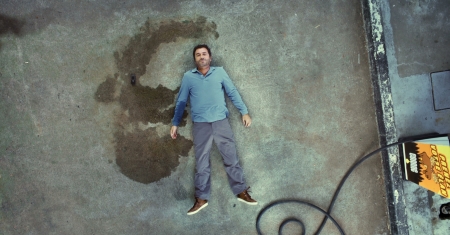 The film’s played naturalistically even while the story grows increasingly absurd. Laugh-lines aren’t emphasised at all, to the point that you might think you were watching a drama. The actors approach their characters more or less realistically. On the other hand the situations are absurd, and the voice-over exaggerates that absurdity. The elk-man himself is obviously fake, the head stuffed felt.
The film’s played naturalistically even while the story grows increasingly absurd. Laugh-lines aren’t emphasised at all, to the point that you might think you were watching a drama. The actors approach their characters more or less realistically. On the other hand the situations are absurd, and the voice-over exaggerates that absurdity. The elk-man himself is obviously fake, the head stuffed felt.
There is a very distinct tone created from the dissonance the realism and the absurdity create between them. But I felt that tone was too subdued. The movie plays everything too straight, and as a result too quiet. You can see how it might have worked; and yet it doesn’t.
It looks like a parody of films such as E.T. The plot takes weird turns but generally follows the template you’d expect: the contact of the human lead with the improbable; the improbable slowly fits into a community; intolerance casts it out again. But if the satirical elements make it hard to tell how seriously too take the themes of alienation, it’s also unclear why it’s using this particular kind of story. The movie’s such an understated parody it becomes hard to tell what’s being parodied.
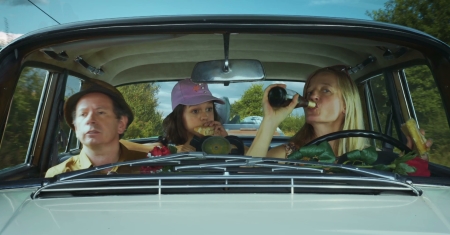 In part I wonder if that’s because I’m so used to this sort of tale — E.T. came out 35 years ago next year — that the absurdity doesn’t register. Surely if your aim is the absurd then a feeling of familiarity is deadly. And yet that’s what this feels like: something which we already know, something comfortable, something repetitive. The elements of strangeness are insufficiently alienating. We’ve seen it all before.
In part I wonder if that’s because I’m so used to this sort of tale — E.T. came out 35 years ago next year — that the absurdity doesn’t register. Surely if your aim is the absurd then a feeling of familiarity is deadly. And yet that’s what this feels like: something which we already know, something comfortable, something repetitive. The elements of strangeness are insufficiently alienating. We’ve seen it all before.
It’s almost obvious to point out that there’s nothing particularly new in the science-fictional (or fantastic) elements. Towards the end an off-the-wall theory for the Elk’s origins is presented that sets up an out-of-nowhere climax, but even the ideas there aren’t especially novel. Rather than use the genre elements as a way to get at the weird, they’re taken as givens. They’re off-the-shelf plot points, used precisely because of their lack of originality.
Surprisingly, the local colour doesn’t play much of an obvious part, either. For the most part the rural setting here could be a rural setting anywhere. I don’t know what I may be missing from an unfamiliarity with French culture, but nothing leapt out at me in this movie as specifically French or specifically Vendéen.
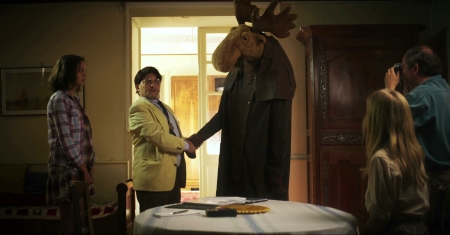 The directing struck me as competent but unremarkable. The visuals weren’t especially interesting, and the timing of the jokes (to the extent one can speak of timing jokes in such a resolutely straight-faced film) not especially sharp. Structurally, the plot of the film seemed to break down into bits — individual scenes felt loosely connected, as though they were so many skits in a sketch-comedy show. (It may or may not be relevant that Labroue has worked on the TV show Les Guignols, a satirical puppet-show that’s been compared to the British Spitting Image.)
The directing struck me as competent but unremarkable. The visuals weren’t especially interesting, and the timing of the jokes (to the extent one can speak of timing jokes in such a resolutely straight-faced film) not especially sharp. Structurally, the plot of the film seemed to break down into bits — individual scenes felt loosely connected, as though they were so many skits in a sketch-comedy show. (It may or may not be relevant that Labroue has worked on the TV show Les Guignols, a satirical puppet-show that’s been compared to the British Spitting Image.)
As a whole, I found it hard to work out what the film was about. There is much to do with alienation, and the claim that the elk is the only animal other than the human who cries (which is completely false). But what to do with that idea? How seriously to take it? Is it only meant as a parody of a plangent line, and the whole movie a mockery of sentimental films about aliens fitting in to society? I would have thought so, frankly, but it’s hard to point to anything in the movie that’s biting enough to make that reading clear. It’s hard to tell where the satire begins and where it ends — and therefore hard to tell the point of the movie.
It is entirely possible that somebody even slightly more in tune with the movie’s general approach would have a much more positive reaction than I did. For myself, I found it pleasant, intermittently amusing, but more than faintly dull. There are interesting elements and interesting ideas in L’Élan. But I didn’t see them come together to make an interesting movie.
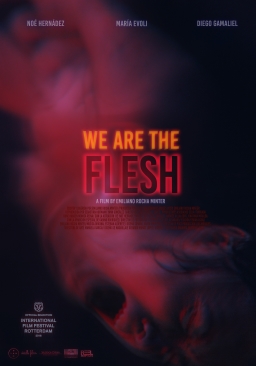 Next I decided to try the Mexican film We Are the Flesh, which promised to be more confrontational. Written and directed by Emiliano Rocha Minter, it follows a brother and sister (Diego Gamaliel and María Evoli) who wander into an abandoned building that is the home of a magus-like figure named Mariano (Noé Hernández). They’re seeking shelter from the outside world, while Mariano’s rebuilding his home into a strange landscape part cave and part womb. He allows them to stay and help him, but exacts further payment as well; and it soon becomes clear he’s playing a deeper game.
Next I decided to try the Mexican film We Are the Flesh, which promised to be more confrontational. Written and directed by Emiliano Rocha Minter, it follows a brother and sister (Diego Gamaliel and María Evoli) who wander into an abandoned building that is the home of a magus-like figure named Mariano (Noé Hernández). They’re seeking shelter from the outside world, while Mariano’s rebuilding his home into a strange landscape part cave and part womb. He allows them to stay and help him, but exacts further payment as well; and it soon becomes clear he’s playing a deeper game.
I said this promised to be a confrontational film, and it is. On my way out of the screening room I was asked by someone who’d seen glimpses of the screen while the movie was playing if it was porn — and if you just see random moments of the film, that is a fair question. I thought for a moment and said no, it’s not porn, but it is more like porn than most things that aren’t porn. There’s much to be said beyond that: there clearly is aesthetic purpose to the images Minter puts on screen, and further matter to the film than its sexual imagery. But it’s the nature of such imagery to stand out, which may be a part of Minter’s point.
I think the film’s a kind of rejection of things like gnosticism and Cartesian rationalism; of all ways of thought that insist on a distinction between flesh and spirit. As the title says clearly, we are the flesh. You can’t get away from the body. The movie’s about a kind of rebirth, even a rebirth of the world (to judge by the final frames of the film). The thematic content is foregrounded in dialogue to an extent, but the film is carried by a strong sense of visual storytelling, propelling the symbolism in the imagery up to the end.
Luckily, the storytelling’s strong, and so is the visual sensibility. Mariano’s apartment changes over the course of the film into a rounded alien landscape constructed of simple matter like wooden frames and packing tape, a disorienting colourful setting that brings a strong air of unreality while being distinctive and interesting to the eye. If the change in the apartment reflects the alteration of consciousness in the characters (and perhaps in the audience), it also creates a space in which one feels anything can happen. A magic space, like the inside of a dream or of an alchemical vessel: a space for transmutation. The actors in this space play unreal, elliptical dialogue with strong emotion; close-ups carry unexpected emotional charge. The result is both visceral and atmospheric.
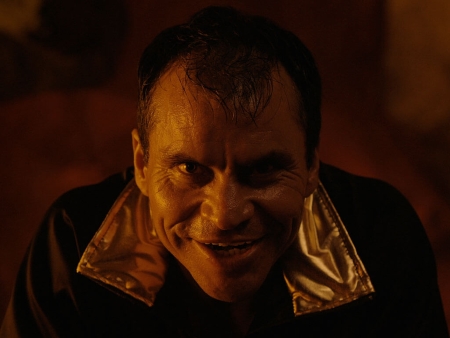 And, of course, there’s the sexual imagery that insists on the matter of the body, on the physicality of procreation and incarnation. Characters have sex and oral sex, Mariano masturbates to orgasm over the brother and sister copulating, there are close-ups of male and female genitalia; how much these things are real and how much the Magic Of Cinema is beside the point. One reacts to it as real, and unlike some movies I’ve seen at Fantasia this year, the sense of witnessing a transgression is undeniable. These things we see are not what we normally see in a normal movie.
And, of course, there’s the sexual imagery that insists on the matter of the body, on the physicality of procreation and incarnation. Characters have sex and oral sex, Mariano masturbates to orgasm over the brother and sister copulating, there are close-ups of male and female genitalia; how much these things are real and how much the Magic Of Cinema is beside the point. One reacts to it as real, and unlike some movies I’ve seen at Fantasia this year, the sense of witnessing a transgression is undeniable. These things we see are not what we normally see in a normal movie.
One may legitimately wonder if the effect is cheap. I feel it works; I feel that the movie’s working a kind of ritual that uses the energies of the transgressive to make its thematic point. I found it undermined the boundaries that I unconsciously impose on a film — what I expect to not see is seen, and the experience of watching a film is made new. Others may disagree, and it would not surprise me if many viewers are knocked out of the story by the things shown on screen.
I think one way or another the movie evokes an extremely dreamlike feel, as the apartment becomes a place of unexpected transformations and taboo violations. The plot takes unexpected turns, adding to the irrational air. Monologues are heavily symbolic, raising questions of madness. It all works, not least because at 79 minutes the film doesn’t wear out its welcome. The surreality creates an almost Lynchian feel, if crueller and less character-centred than Lynch. The archetypes are plainer here.
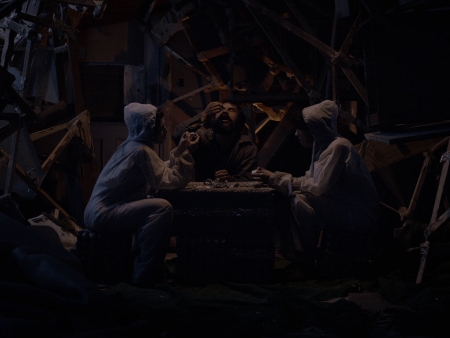 It’s very definitely a genre piece. It’s a surreal fantasy about a magus-figure manipulating younger characters for his own ends, what has been called a godgame. What may be unusual is the concentration on the carnal: there’s nothing conventionally mystical, and little that can be called ascetic, in the magus-hermit’s story here. And yet structurally the pattern is clear — perhaps more clear as a structure than as a logically-constructed screenplay.
It’s very definitely a genre piece. It’s a surreal fantasy about a magus-figure manipulating younger characters for his own ends, what has been called a godgame. What may be unusual is the concentration on the carnal: there’s nothing conventionally mystical, and little that can be called ascetic, in the magus-hermit’s story here. And yet structurally the pattern is clear — perhaps more clear as a structure than as a logically-constructed screenplay.
I don’t think this is a flawless movie by any means. The dialogue is often interesting, but also frequently over-heavy, too bluntly symbolic. Certainly one can argue that reflections on perversion, solitude, and love are adolescent. There is a repetitive feel at times, caused by the lack of individuation. Some elements, notably other characters that wander in from the outside, feel over-random.
Still, in general this is a movie that hits what it aims at. It builds a world in a confined space, and turns what might have been a claustrophobic environment into a distinctive and colourful visual setting. It creates a sense of dream and of ritual, setting up a tale that moves through an odd structure to (what I take to be) a kind of reincarnation. It uses extreme imagery in the service of a thematic point. I don’t particularly come away agreeing with its point, but then that’s not at issue. What you see here isn’t an argument but an illustration. It’s not a simple work, and not what I’d call pleasant, but it is largely a success.
Three movies on the day, each heavily ambitious in its own way. All of them creating fantastical stories on a limited budget. Two of them worked, as stories and as film worlds. Here today, as elsewhere at Fantasia, I had the sense of seeing new things: of genre realised as a way of articulating the visionary. Of presenting a sensibility that could not be realised in more mimetic stories. I was glad to have seen them, and sad there were only two more days left to find similar surprises at this year’s festival.
(You can find links to all my Fantasia 2016 diaries here.)
Matthew David Surridge is the author of “The Word of Azrael,” from Black Gate 14. You can buy his first collection of essays, looking at some fantasy novels of the twenty-first century, here. His second collection, looking at some fantasy from the twentieth century, is here. You can find him on Facebook, or follow his Twitter account, Fell_Gard.